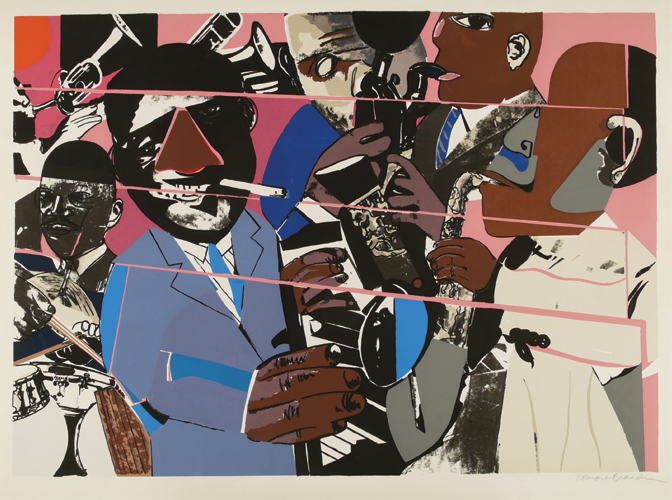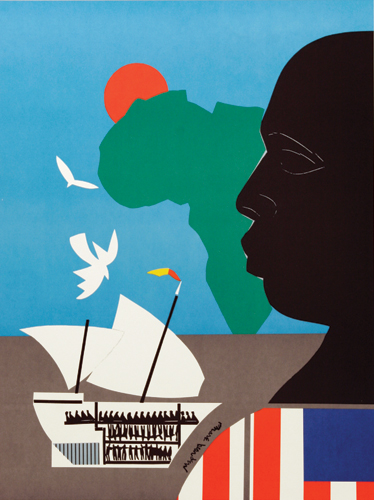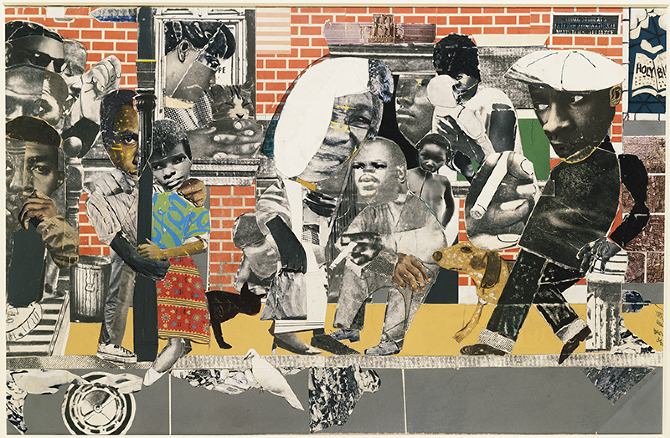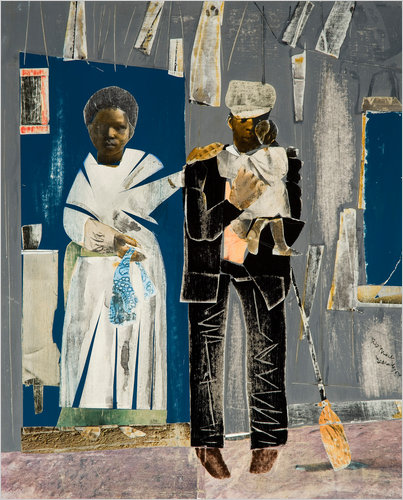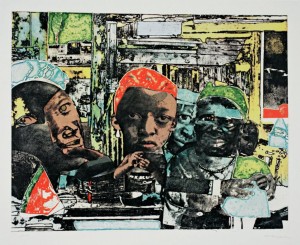
The Train (1975) is one of the 12 works of Romare Bearden in the MoMA Collection.
Deborah Wye, Artists and Prints: Masterworks from The Museum of Modern Art, New York: The Museum of Modern Art, 2004, p. 221
Having grown up during the Harlem Renaissance of the 1920s, Romare Bearden devoted his life and art to redefining, as he said, “the image of man in terms of the Negro experience I know best.” After painting as a Social Realist in the 1930s and 1940s, and then in a mode derived from Abstract Expressionism in the 1950s, Bearden ultimately found his own voice in the imaginative collages he made from 1964 on. Using a fragmented style inspired by the rhythms of jazz, he assembled magazine clippings into phantasmagorical invocations of the myths and rituals of black American life.
Bearden did not take up printmaking seriously until the late 1960s, when he began to frequent the Printmaking Workshop, a non-profit studio run by his longtime friend, the artist and master printer Robert Blackburn. Over the next two decades he worked there and with other publishers and printers, eventually completing more than one hundred editioned prints in various techniques, as well as dozens of monotypes. Many of Bearden’s prints, particularly his lithographs and screenprints, are based on existing collages and monotypes.
With Blackburn’s encouragement he also made some experimental collagraphs and intaglio prints that engage the collage process and printmaking in unusual and inventive ways. In The Train, for example, he recast a 1964 collage by adding new textures and colors. This was achieved by using mesh screens and photography to generate the photogravure plate, which was subsequently cut up so colored areas could be inked separately and reassembled jigsaw style for printing.
ROMARE BEARDEN
Most of the artists who serve as my role models—the famous ones, anyway—never had to deal with the phenomenon known as the Day Job. Picasso, Braque, Balthus, De Kooning et al, suffered through periods of extreme poverty before achieving financial stability, or, in some cases, extreme wealth, from their art. De Kooning did take odd jobs for years on the side to make ends meet, but after he made the decision to become a full-time studio artist, he never held a regularly scheduled job again in his life. (He did work on the Federal Arts Project, but since that was actually a government-funded job that paid him to make art, I don’t count that as a real day job). Some of them—Max Beckmann, Philip Guston, and Hans Hoffmann come to mind— had teaching gigs, either short- or long-term, but that’s about as close to a day job as they ever got. There was one exception, however, and his name was Romare Bearden.
As an adult, Bearden worked as a full-time caseworker for the New York City Department of Welfare, a job he held from 1938 until he retired in 1967. The job provided him with a regular salary, which allowed him to maintain a studio, but it also forced him to paint in the evenings and on weekends. What’s notable is that most of the works for which Bearden ultimately became known—his collages—were not created by him until after he retired from the Department of Welfare. That strengthens my contention that day jobs take something vital from an artist, namely, their best time and energy. That is what frustrates me about my own day job, at times.
Bearden first came to my attention in 1984, when a retrospective on his work came to my hometown art museum in Grand Rapids, Michigan. This was another of those instances when I was not ready to receive an opportunity that had been dropped into my lap. I went to see the exhibit, but I simply could not appreciate what I was looking at, since Bearden’s work is Cubist in nature. It wasn’t until I had my epiphany about Cubism that I was able to go back to Bearden’s work, years later, and comprehend what I was seeing.
Bearden’s career took an interesting arc. He first came to prominence as a satirical cartoonist, studying at the Art Students League under George Grosz. He lived in the intense cultural milieu that was Harlem in the 1930s, where he was able to associate with many up and coming African American artists, musicians, and writers. He also met luminaries like Duke Ellington and Eleanor Roosevelt through his mother, who was heavily involved in Harlem’s social, political, and cultural scene as well. He continued working as an artist during a stint in the Army during World War II, albeit as a painter, and achieved some local success in New York, participating in group shows in the mid 1940s. He befriended artists like Stuart Davis, Carl Holty, and even Joan Miro, who was exiled here during the war. Bearden worked in oils and gouache, and began experimenting with Cubism, exploring themes that he would revisit in his collages in the 1960s and beyond.
Bearden first worked in collage in the early 1960s, in collaboration with other artists. He soon began using collage for his own work, creating the so-called “Projections” that brought him widespread critical attention and cemented his reputation. The projections (example above) were essentially a type of photomontage, exploring themes of Black, urban life. After this point, Bearden did the bulk of his work in collage, working in that medium for the rest of his life, until his death in 1988.
What is it about Bearden’s work that has influenced me? To begin with, there is his use of lush color, with harmonies that are often both bright and subtle at the same time. I also love his compositions, built on a Cubist grid, solid as stone. The way the contours and shapes in his collages are reinforced and complimented by the segmented photographs he uses as source material is uncanny. If you’re not familiar with his work, I urge you to check it out. A good place to start is the book “Romare Bearden: His Life & Art” by Myron Schwartzman. It’s a combination biography/coffee-table art book, containing fascinating interviews with the artist, and loaded with color plates. It’s an absorbing introduction to a great modern artist.
Posted 25th June 2010 by Thomas Ganzevoort
Copyright/courtesy: Romare Bearden Foundation.



